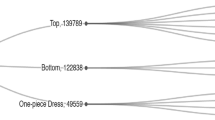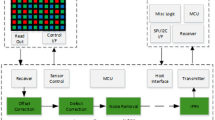Abstract
With the increasing development of e-commerce platforms, it has become a growing demand to use collar types to retrieve clothing on shopping websites. However, due to the lack of image training data sets for collar classification, the task of collar image classification faces many challenges such as multiple poses, multiple noises, and small detection areas. There is currently no specific collar image classification research report. The existing image classification algorithms are not ideal in the actual collar classification task. To this end, this paper collected 39248 images of network collars, constructed a small collar image data set with four categories called Collar-Four, and proposed a classification algorithm called SqueezeCNet. The algorithm is improved by adding a CBAM block to the Fire module in SqueezeNet. The improved module is called FireC. In the experimental part, the initialization model and transfer model of SqueezeCNet are compared with the random initialization model and transfer model of traditional convolutional neural networks on the Collar-Four dataset. The initialization model of SqueezeCNet obtains an accuracy of 76.66%, and the classification effect is better than random initialization model and transfer model of traditional convolutional neural networks. The transfer model of SqueezeCNet has an accuracy of 79.74%, which is the best among all experimental models. In addition, an ablation experiment was performed on the classification algorithm proposed in this paper, which further proved the effectiveness of the method in this paper. Experiments show that the application of SqueezeCNet on the Collar-Four dataset is feasible, and this algorithm can effectively solve the real-world collar image classification problem with noisy background.
Access this chapter
Tax calculation will be finalised at checkout
Purchases are for personal use only
Similar content being viewed by others
References
Liu, Z., Luo, P., Qiu, S., et al.: DeepFashion: powering robust clothes recognition and retrieval with rich annotations. In: Proceedings of the IEEE Conference on Computer Vision and Pattern Recognition, pp. 1096–1104 (2016)
Ge, Y., Zhang, R., Wang, X., et al.: DeepFashion2: a versatile benchmark for detection, pose estimation, segmentation and re-identification of clothing images. In: Proceedings of the IEEE Conference on Computer Vision and Pattern Recognition, pp. 5337–5345 (2019)
Kiapour, M.H., Han, X., Lazebnik, S., Berg, A.C., Berg, T.L.: Where to buy it: matching street clothing photos in online shops. In: ICCV, pp. 3343–3351. IEEE Computer Society (2015)
Hinton, G., Salakhutdinov, R.R.: Reducing the dimensionality of data with neural networks. Science 313(5786), 504–507 (2006)
Zoran, D., Chrzanowski, M., Huang, P., et al.: Towards robust image classification using sequential attention models. arXiv: Computer Vision and Pattern Recognition (2019)
Xie, Q., Hovy, E., Luong, M., et al.: Self-training with Noisy student improves ImageNet classification. arXiv: Learning (2019)
Bertinetto, L., Muller, R., Tertikas, K., et al.: Making better mistakes: leveraging class hierarchies with deep networks. arXiv: Computer Vision and Pattern Recognition (2019)
Wu, Y., Zhang, K., Wu, D., et al.: Person re-identification by multi-scale feature representation learning with random batch feature mask. IEEE Trans. Cogn. Dev. Syst. (2020)
Chen, Z., Wei, X., Wang, P., et al.: Multi-label image recognition with graph convolutional networks. In: Proceedings of the IEEE Conference on Computer Vision and Pattern Recognition, pp. 5177–5186 (2019)
Wang, G., Wang, K., Lin, L., et al.: Adaptively connected neural networks. In: Proceedings of the IEEE/CVF Conference on Computer Vision and Pattern Recognition, pp. 1781–1790 (2019)
Yuan, C., et al.: An effective image classification method for shallow densely connected convolution networks through squeezing and splitting techniques. Appl. Intell. 49(10), 3570–3586 (2019). https://doi.org/10.1007/s10489-019-01468-7
Goodfellow, I., Bengio, Y., Courville, A.: Deep Learning, vol. 1, pp. 326–366. MIT press, Cambridge (2016)
Gu, J., et al.: Recent advances in convolutional neural networks. arXiv preprint arXiv:1512.07108 (2015)
Pan, S.J., Yang, Q.: A survey on transfer learning. IEEE Trans. Knowl. Data Eng. 22(10), 1345–1359 (2010)
Deng, J., Dong, W., Socher, R., et al.: ImageNet: a large-scale hierarchical image database. In: 2009 IEEE Conference on Computer Vision and Pattern Recognition, pp. 248–255. IEEE (2009)
Wu, Y., Qin, X., Pan, Y., et al.: Convolution neural network based transfer learning for classification of flowers. In: 2018 IEEE 3rd International Conference on Signal and Image Processing (ICSIP), pp. 562–566. IEEE (2018)
Seo, Y., Shin, K.S.: Image classification of fine-grained fashion image based on style using pre-trained convolutional neural network. In: 2018 IEEE 3rd International Conference on Big Data Analysis, pp. 387–390. IEEE (2018)
Xiao, T., Xu, Y., Yang, K., et al.: The application of two-level attention models in deep convolutional neural network for fine-grained image classification. In: Proceedings of the IEEE Conference on Computer Vision and Pattern Recognition, pp. 842–850 (2015)
Hu, J., Shen, L., Albanie, S., et al.: Squeeze-and-excitation networks. IEEE Trans. Pattern Anal. Mach. Intell. 1 (2019)
Wang, X., Girshick, R., Gupta, A., et al.: Non-local neural networks. In: Proceedings of the IEEE Conference on Computer Vision and Pattern Recognition, pp. 7794–7803 (2018)
Fu, J., Liu, J., Tian, H., et al.: Dual attention network for scene segmentation. In: Proceedings of the IEEE/CVF Conference on Computer Vision Pattern Recognition, pp. 3146–3154 (2019)
Woo, S., Park, J, Lee, J., et al.: CBAM: convolutional block attention module. In: Proceedings of the European Conference on Computer Vision, pp. 3–19 (2018)
Iandola, F., Han, S., Moskewicz, M.W., et al.: SqueezeNet: AlexNet-level accuracy with 50x fewer parameters and <0.5 MB model size. arXiv: Computer Vision and Pattern Recognition (2017)
He, K., Zhang, X., Ren, S., Sun, J.: Deep residual learning for image recognition. In: Proceedings of the IEEE Conference on Computer Vision and Pattern Recognition, Las Vegas, USA, pp. 770–778 (2016)
Simonyan, K., Zisserman, A.: Very deep convolutional networks for large-scale image recognition. arXiv preprint arXiv:1409.1556 (2014)
Saining, X., et al.: Aggregated residual transformations for deep neural networks. In: Proceedings of the IEEE Conference on Computer Vision and Pattern Recognition (2017)
Gao, S.H., Cheng, M.M., Zhao, K., et al.: Res2Net: a new multi-scale backbone architecture. arXiv preprint arXiv:1904.01169 (2019)
Li, Xiang, et al.: Selective Kernel networks. In: Proceedings of the IEEE Conference on Computer Vision and Pattern Recognition (2019)
Acknowledgment
This work is partially supported by the National Natural Science Foundation of China under Grant Nos. 61962006, 61802035, 61772091; the Project of Science Research and Technology Development in Guangxi under Grant Nos. AA18118047, AD18126015, AB16380272; thanks to the support by the BAGUI Scholar Program of Guangxi Zhuang Autonomous Region of China (2016 [21], 2019 [79]); the National Natural Science Foundation of Guangxi under Grant Nos. 2018GXNSFAA138005.
Author information
Authors and Affiliations
Corresponding author
Editor information
Editors and Affiliations
Rights and permissions
Copyright information
© 2020 Springer Nature Switzerland AG
About this paper
Cite this paper
Qin, X., Huang, C., Wu, J., Yuan, C. (2020). A Classification Algorithm for Real Collar Images. In: Huang, DS., Bevilacqua, V., Hussain, A. (eds) Intelligent Computing Theories and Application. ICIC 2020. Lecture Notes in Computer Science(), vol 12463. Springer, Cham. https://doi.org/10.1007/978-3-030-60799-9_31
Download citation
DOI: https://doi.org/10.1007/978-3-030-60799-9_31
Published:
Publisher Name: Springer, Cham
Print ISBN: 978-3-030-60798-2
Online ISBN: 978-3-030-60799-9
eBook Packages: Computer ScienceComputer Science (R0)





